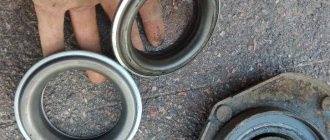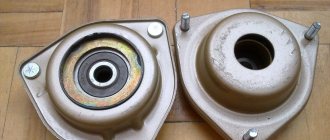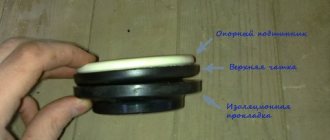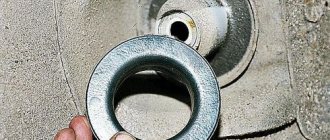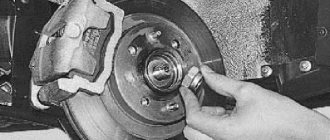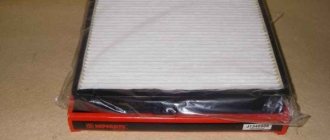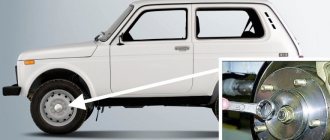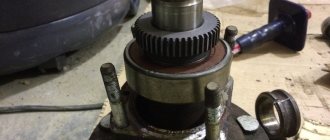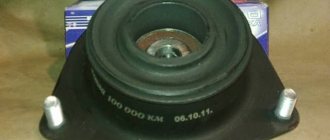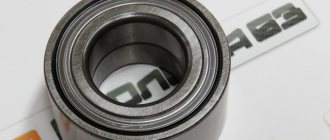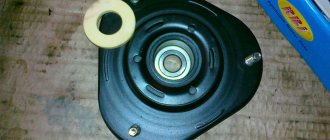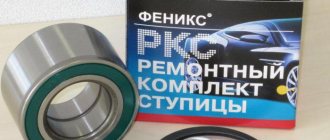Lacetti » Maintenance and repair
The car suspension is an intermediate link between the wheel and the body. Its elements absorb shock from hitting a bump, allow the wheel to move up and down and prevent the body from swaying.
Shock absorbers are responsible for the second and third functions. On the Chevrolet Lacetti they are hydraulic gas-filled. This article will tell you what shock absorber struts are installed on sedans, station wagons and hatchbacks and how to independently determine their serviceability and replace them.
Main signs of malfunction of Chevrolet Lacetti suspension components
Pay attention to the condition of the suspension and perform a preventive inspection if the following signs of malfunction appear:
- the appearance of extraneous noise (knocking, creaking, humming, etc.);
- uneven steering efforts;
- inadequate behavior of the suspension while driving;
- uneven tire wear;
- squealing when turning;
- different steering efforts when turning right and left;
- shifting the trajectory of movement on a flat road.
Symptoms and troubleshooting of the shock absorber strut
Faulty suspension parts produce squeaks and dull knocks when driving on uneven roads. To determine the health of the node, you need to:
- Drive 10–15 kilometers.
- Stop on level ground.
- Rock the front and rear of the car, pressing hard on the hood and trunk lid. If the body swings more than 1 time up and 1 time down after the swing stops, then the racks are faulty.
- Rock the car, pressing hard on the fender or rear roof support from each side of the fender to determine which part has failed.
Front suspension
The front suspension diagram is shown in the figure:
The ball joints, hubs, and struts are subject to the greatest wear. The ball joint must be replaced every 100 - 150 thousand kilometers. Compounding the difficulty of replacing the ball joint is the fact that it is secured to the arm with rivets. The most problematic part of the hub assembly is the bearing. Despite the fact that the bearing has a long service life, given the state of Russian roads, it can fail after 50,000 - 100,000 kilometers. Replacing a wheel bearing is a complex technological operation.
A photo of the independent suspension is shown in the figure:
The car uses the classic MacPherson suspension design. The main load when driving on uneven road surfaces falls on the shock-absorbing struts, which absorb vibrational energy. The Chevrolet Lacetti uses a gas-filled hydraulic shock absorber.
The shock absorber strut consists of 11 components (part number 4564584).
When servicing a shock absorber strut, the technical condition of the shock absorber, spring, and thrust bearing is checked. Routine maintenance involves replacing the upper and lower gaskets.
The mounting locations for the subframe are shown in the figure:
The attachment points for the subframe to the lever are 1 and 3, the stabilizer is 5, the steering mechanism is 6. The ball joint is attached to the lever using 3 rivets. When diagnosing the suspension, the condition of the fastening elements, the degree of tightening of the bolts and nuts, and the integrity of the subframe (absence of traces of significant corrosion) must be checked.
Photo of the steering knuckle mounting points (items ST96488824, 96454298).
Place of attachment of the tie rod end - 1, to the shock absorber bracket - 5, to the brake shoe guide - 6, ball joint pin - 8. Place of installation of the wheel speed sensor - 2. When carrying out repair work, it is sometimes advisable to change the design of the steering knuckle assembly. If such a replacement is made with a contract spare part, it should be inspected by a specialist before purchasing.
How to change a strut bearing
To carry out work on replacing the strut supports of a Chevrolet lacetti hatchback, station wagon or sedan, we will need a high-quality tool. During the work process it will be useful:
- jack;
- torque wrench;
- a set of standard car heads;
- ties for removing springs;
First of all, you should dismantle the rack:
- We jack up the car and place wheel chocks under the rear wheels;
- We dismantle the wheel and remove the ball pin. As a result, we gain access directly to the site of the lower fixation of the node;
- We open the hood and, using two keys - “9” and “17”, tear off the clamps;
- We dismantle the lateral stability stabilizer;
- Unscrew the nut securing it to the steering knuckle using the 17th key;
- We take out the fastening bolts, completely unscrew the upper part and disconnect the rack;
Rear suspension
The rear suspension components of the Chevrolet Lacetti (disassembled) are shown in the figure:
The hub assembly and shock absorber strut are the most susceptible to wear. The service life of these devices is usually about 120,000 - 150,000 kilometers.
Photo of the rear suspension assembly.
The rear shock absorbers are hydraulic gas-filled.
The structure and elements of the shock absorber strut.
During routine maintenance of the rear shock absorber strut, the right and left gaskets and the telescopic strut are replaced (in case of critical wear).
Chevrolet Lacetti hub:
The hub includes a wheel speed sensor and a bearing. This unit cannot be disassembled during the repair process; it is changed as a unit (article 96639607). The price of a complete hub is from 5,000 rubles, an analogue (manufacturer catalog number WB0517) is about 3,000 rubles.
Chevrolet Cruze
The balance between handling and comfort in the Cruze is shifted towards the latter. Its chassis has no more sportiness in its genome than vitamin C in chicken soup. The suspension is rather tuned for comfortable and leisurely movement in space. But the Cruze's handling is immeasurably better than its predecessor.
The Cruze is moderately rolly, but steers accurately. In the zero zone there is plenty of information on the rim. But, unfortunately, that’s all it is. As soon as you turn the steering wheel a little, not a trace remains of this information, first there is a noticeable step in the force, then the hydraulic booster is abruptly engaged and the steering wheel falls in the direction of rotation. The steering turns out to be discrete; in order to change the trajectory smoothly, you need to get used to it.
Suspension diagnostics and repair
The main symptoms and causes of the malfunction, diagnostic methods and methods of troubleshooting and repair are given in the table:
| Symptom of malfunction | Possible reasons | Diagnostic and troubleshooting methods |
| The car steers to the right or left | Incorrect toe adjustment | Diagnostics and adjustment on the bench |
| Knock in the area of the front wheel (when driving over rough terrain, when turning) | Worn ball joint, faulty tie rod ends | Determine which of the ball joints is faulty and replace the ball joint. |
| Check the steering rods; if faulty, replace them | ||
| Noise in the front wheel area | Wheel bearing wear | Replace the wheel bearing |
| Noise in the rear wheel area | Wear of rear hub bearings | Replace the rear hub assembly |
| Extraneous sounds when driving over rough terrain | Shock absorber malfunction | Replacing shock absorbers |
| Suspension rattles when driving on uneven road surfaces | Wear of suspension components (gaskets, shock absorbers, etc.), weakening of fastening elements | Carrying out complete diagnostics of the suspension, replacing worn components |
| Knock from behind | Wear of rear suspension components (struts, rods, spacers) | Rear suspension diagnostics, replacement of worn-out devices |
Carrying out timely suspension repairs is an indispensable condition for the safe operation of a Chevrolet Lacetti. In this case, only high-quality parts and assemblies should be used, and the technological map of restoration work should be strictly followed.
